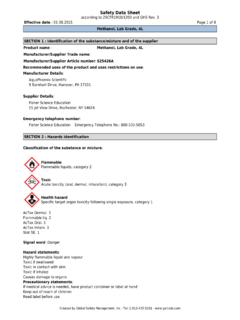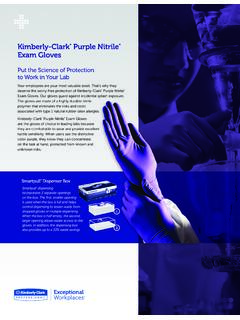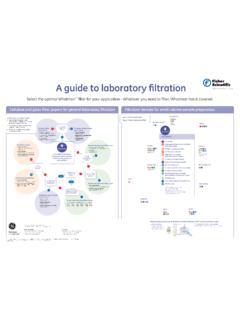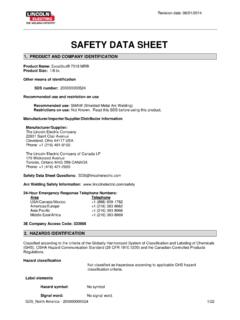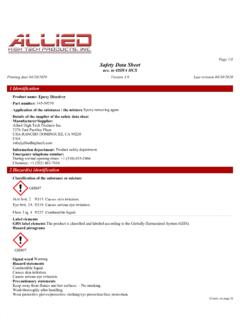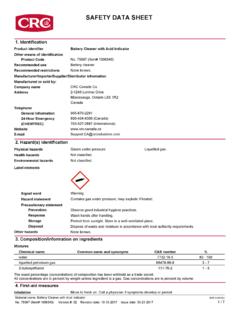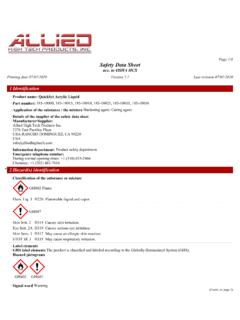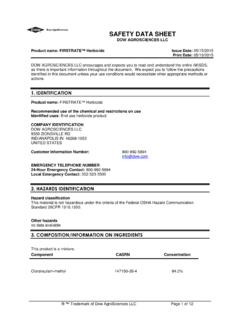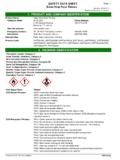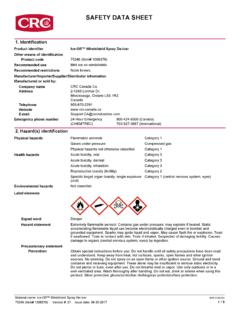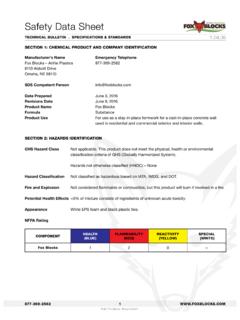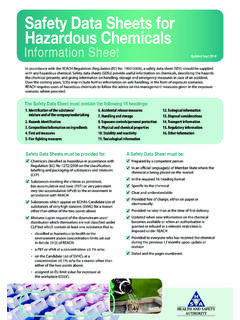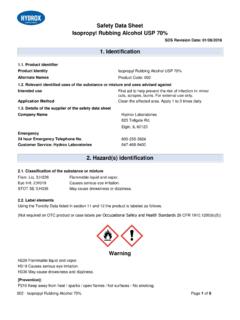Transcription of Safety Data Sheet - Fisher Scientific
1 Safety data Sheetaccording to 29 CFR1910/1200 and GHS Rev. 3 Effective date : 1 of 7 Sodium Hydroxide, by Global Safety Management, Inc. -Tel: 1-813-435-5161 - 1 : Identification of the substance/mixture and of the supplierProduct name :Sodium Hydroxide, Trade name:Manufacturer/Supplier Article number:S25881 Recommended uses of the product and uses restrictions on use:Manufacturer Details:AquaPhoenix Scientific9 Barnhart Drive, Hanover, PA 17331 Supplier Details: Fisher Science Education15 Jet View Drive, Rochester, NY 14624 Emergency telephone number: Fisher Science Education Emergency Telephone No.: 800-535-5053 SECTION 2 : Hazards identificationClassification of the substance or mixture:CorrosiveSerious eye damage, category 1 Corrosive to metals, category 1 Skin corrosion, category 1 BSkin Corr.
2 1 BEye corr. 1 Metal Corr. 1 Signal word :DangerHazard statements:May be corrosive to metalsCauses severe skin burns and eye damageCauses serious eye damagePrecautionary statements:If medical advice is needed, have product container or label at handKeep out of reach of childrenRead label before useKeep only in original containerDo not breathe dust/fume/gas/mist/vapours/sprayWash .. thoroughly after handlingWear protective gloves/protective clothing/eye protection/face protectionAbsorb spillage to prevent material damageIF ON SKIN (or hair): Remove/Take off immediately all contaminated clothing. Rinse skin with water/showerIF IN EYES: Rinse cautiously with water for several minutes. Remove contact lenses if present and easy to rinsingIF SWALLOWED: Rinse mouth.
3 Do NOT induce vomitingWash contaminated clothing before reuseIF INHALED: Remove victim to fresh air and keep at rest in a position comfortable for breathingSafety data Sheetaccording to 29 CFR1910/1200 and GHS Rev. 3 Effective date : 2 of 7 Sodium Hydroxide, by Global Safety Management, Inc. -Tel: 1-813-435-5161 - call a POISON CENTER or doctor/physicianStore in a corrosive resistant/.. container with a resistant inner linerStore locked upDispose of contents/container to ..Other Non-GHS Classification:WHMISENFPA/HMISNFPA SCALE (0-4)HMIS RATINGS (0-4)SECTION 3 : Composition/information on ingredientsIngredients:CAS 1310-73-2 Sodium Hydroxide2 %CAS 7732-18-5 Deionized Water98 %Percentages are by weightSECTION 4 : First aid measuresDescription of first aid measuresAfter inhalation: Move exposed individual to fresh air.
4 Loosen clothing as necessary and position individual ina comfortable medical advice if discomfort or irritation breathing difficult, give skin contact: Take off contaminated clothing and shoes affected area with soap medical attention if irritation, discomfort eye contact: Protect unexposed eye. Rinse/flush exposed eye(s) gently using water for 15-20 contact lens(es) if able to do so during rinsing. Immediately get medical swallowing: Rinse mouth thoroughly. Do not induce vomiting. Have exposed individual drink sips ofwater. Seek medical attention if irritation, discomfort or vomiting important symptoms and effects, both acute and delayed:Irritation, Nausea,Headache, Shortness of breath.;Indication of any immediate medical attention and special treatment needed: Safety data Sheetaccording to 29 CFR1910/1200 and GHS Rev.
5 3 Effective date : 3 of 7 Sodium Hydroxide, by Global Safety Management, Inc. -Tel: 1-813-435-5161 - seeking medical attention, provide SDS document to 5 : Firefighting measuresExtinguishing mediaSuitable extinguishing agents: If in laboratory setting, follow laboratory fire suppression procedures. Useappropriate fire suppression agents for adjacent combustible materials or sources of ignitionFor Safety reasons unsuitable extinguishing agents:Special hazards arising from the substance or mixture:Combustion products may include carbon oxides or other toxic decomposition can lead torelease of irritating gases and for firefighters:Protective equipment: Use NIOSH-approved respiratory protection/breathing information (precautions): Move product containers away from fire or keep cool with waterspray as a protective measure, where 6 : Accidental release measuresPersonal precautions, protective equipment and emergency procedures:Wear protective equipment.
6 Transfer to a disposal or recovery respiratory protective deviceagainst the effects of fumes/dust/aerosol. Keep unprotected persons away. Ensure adequate from ignition sources. Protect from precautions:Prevent from reaching drains, sewer or waterway. Collect contaminated soil for characterization per Section 13 Methods and material for containment and cleaning up:If in a laboratory setting, follow Chemical Hygiene Plan into properly labeled containers forrecovery or disposal. If necessary, use trained response liquid and dilute with with dilute acid solutions. Decant water to drain with excess water. Absorb with suitable of remaining solid as normal refuse. Always obey local to other sections:SECTION 7 : Handling and storagePrecautions for safe handling:Absorb spillage to prevent material damage due to corrosiveness to metal.
7 Avoid contact with eyes, skin, andclothing. Wash hands after handling. Do not mix with good hygiene procedures when handlingchemical materials. Use only in well ventilated for safe storage, including any incompatibilities:Protect from freezing and physical ventilation for containers. Avoid storage near extreme heat,ignition sources or open flame. Store away from foodstuffs. Store away from oxidizing in cool, dryconditions in well sealed containers. Store with 8 : Exposure controls/personal protectionSafety data Sheetaccording to 29 CFR1910/1200 and GHS Rev. 3 Effective date : 4 of 7 Sodium Hydroxide, by Global Safety Management, Inc. -Tel: 1-813-435-5161 - Parameters:1310-73-2, Sodium Hydroxide, OSHA PEL TWA 2 mg/m31310-73-2, Sodium Hydroxide, ACGIH TLV TWA 2 mg/m3 Appropriate Engineering controls:Emergency eye wash fountains and Safety showers should be available inthe immediate vicinity of exhaust ventilation orother engineering controls to keep the airborne concentrations of vaporor dusts (total/respirable) below the applicable workplace exposure limits(Occupational Exposure Limits-OELs) indicated protection:Not required under normal conditions of use.
8 Use suitable respiratoryprotective device when high concentrations are present. Use suitablerespiratory protective device when aerosol or mist is formed. For spills,respiratory protection may be of skin:The glove material has to be impermeable and resistant to the product/the substance/ the preparation being of the glovematerial on consideration of the penetration times, rates of diffusion andthe protection: Safety glasses with side shields or hygienic measures:The usual precautionary measures are to be adhered to when handlingchemicals. Keep away from food, beverages and feed remove all soiled and contaminated clothing. Wash handsbefore breaks and at the end of work. Do not inhalegases/fumes/dust/mist/vapor/aeroso ls.
9 Avoid contact with the eyes 9 : Physical and chemical propertiesAppearance (physicalstate,color):Clear, colorless liquidExplosion limit lower:Explosion limit upper:Non ExplosiveNon ExplosiveOdor:OdorlessVapor pressure:14mmHg @ 20 COdor threshold:Not DeterminedVapor density:>1pH-value:AlkalineRelative density:Approx 1 Melting/Freezing point:Approx 0 CSolubilities:Soluble in WaterBoiling point/Boilingrange:Approx 100 CPartition coefficient (n-octanol/water):Not DeterminedFlash point (closedcup):Not DeterminedAuto/Self-ignitiontemperature: Not DeterminedEvaporation rate:Not DeterminedDecompositiontemperature:Not DeterminedFlammability(solid,gaseous):No t DeterminedViscosity:a. Kinematic:Not Determinedb. Dynamic: Not DeterminedDensity: Not DeterminedSECTION 10 : Stability and reactivityReactivity:Chemical stability:No decomposition if used and stored according to hazardous reactions:Conditions to avoid:Incompatible materials, excess heatSafety data Sheetaccording to 29 CFR1910/1200 and GHS Rev.
10 3 Effective date : 5 of 7 Sodium Hydroxide, by Global Safety Management, Inc. -Tel: 1-813-435-5161 - materials:acids, Organic materials, Chlorinated solvents, Aluminum, Phosphorus, Tin/tin oxides,ZincHazardous decomposition products:sodium oxides, hydrogen. Carbon oxides (CO, CO2).SECTION 11 : Toxicological informationAcute Toxicity: No additional Toxicity: No additional Irritation: No additional :No additional Target Organ (STOT):No additional Measures:No additional :No additional :No additional Toxicity:No additional 12 : Ecological informationEcotoxicity Persistence and degradability: Readily degradable in the potential: Not in soil:Other adverse effects:SECTION 13 : Disposal considerationsWaste disposal recommendations:Product/containers must not be disposed together with household garbage.
